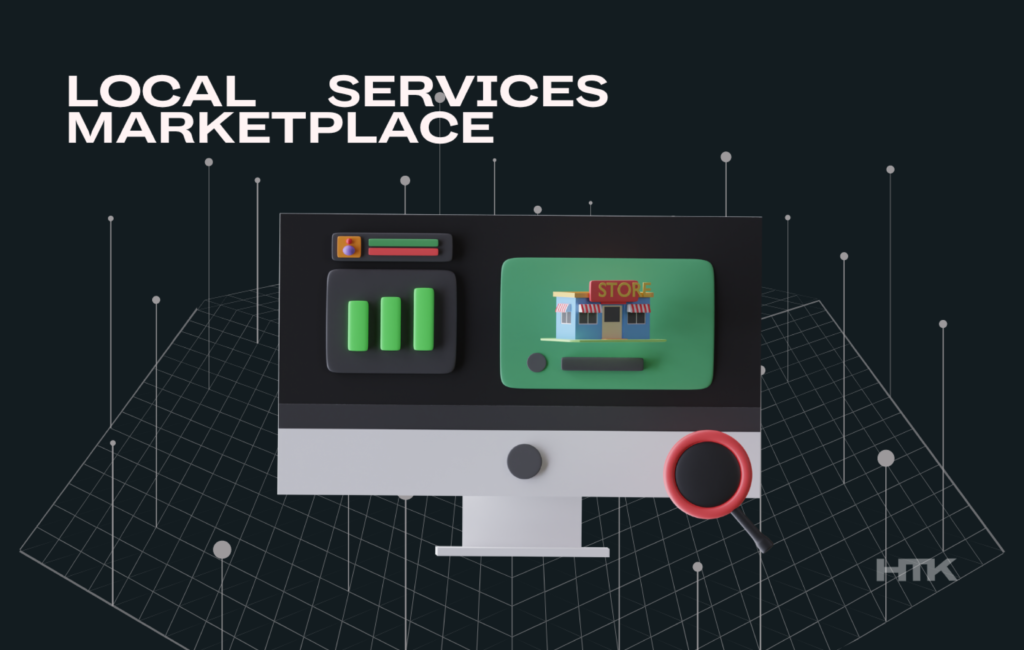How to Create an Online Service Marketplace
- What is an Online Service Marketplace?
- Types of Service Marketplaces
- How Much Does It Cost to Develop an Online Service Marketplace?
- Why Build an Online Service Marketplace?
- Advantages of Creating an Online Services Marketplace
- What Business Models are Used in Service Marketplaces?
- Building Your Service Marketplace: Step-by-Step Guide
- Technical Solutions for Online Service Marketplaces
- Services Marketplace Examples
- Service-Focused vs. Product-Focused Marketplaces
- Traditional Marketplace vs. Managed Marketplace
- Get Started with Your Online Service Marketplace Today!
- Final Thoughts
What is an Online Service Marketplace?
An online service marketplace is a digital platform where users can search for, offer, and book various services. These services can range from freelance work, like graphic design and writing, to physical tasks, such as plumbing and house cleaning.
Service providers list their offerings, and customers browse these listings to find and hire the services they need. Platforms like Fiverr, Uber, and Airbnb are successful service marketplaces. They foster transactions and work between buyers and providers. The marketplace typically earns revenue through fees charged to either the service providers, the customers, or both.

Types of Service Marketplaces
Service marketplaces come in various forms. Each of them tries to meet specific consumer and provider needs. Here’s an overview of the different types:
- Freelance: Fiverr, Upwork
Platforms where freelancers offer services like writing, graphic design, web development outsourcing, programming, and more. Clients can browse profiles, review portfolios, and hire freelancers for specific projects.
- Fitness and Wellness: WellnessLiving, WeStrive
These platforms connect users with fitness trainers, wellness coaches, and health professionals. There are services such as personal training, yoga sessions, and wellness consultations.
- E-learning: Udemy, Coursera
Sites where instructors offer courses on various subjects. Students can enroll in courses ranging from academic subjects to professional skills and hobbies.
- Taxi Booking: Uber, BlaBlaCar, Lyft
Platforms that allow users to book rides from nearby drivers. These services provide convenience, real-time tracking, and various vehicle options.
- Rental: Airbnb, Booking.com
Websites where property owners can list their spaces for rent, whether for short-term stays or longer durations. Users can book accommodations ranging from apartments to unique stays like treehouses.
Online Service Marketplaces
| Marketplace | Year founded | Country | Services provided | Revenue / Growth (2022) |
| Handy | 2012 | USA | Cleaning, plumbing, electrical, furniture assembly, etc. | $1.5 billion / 50% |
| TaskRabbit | 2008 | USA | Small household services, grocery delivery, furniture assembly, dog walking, etc. | $1 billion / 40% |
| Helpling | 2014 | Germany | Cleaning | €200 million / 30% |
| StyleSeat | 2007 | USA | Beauty services | $500 million / 25% |
| Vagaro | 2007 | USA | Beauty services | $300 million / 20% |
| Treatwell | 2015 | UK | Beauty services | £100 million / 15% |
| DoorDash | 2013 | USA | Food delivery | $25 billion / 30% |
| Uber Eats | 2014 | USA | Food delivery | $50 billion / 40% |
| Postmates | 2011 | USA | Food delivery | $10 billion / 25% |
| Uber | 2009 | USA | Taxi service | $170 billion / 45% |
| Lyft | 2012 | USA | Taxi service | $30 billion / 35% |
| Bolt | 2013 | Estonia | Taxi service | €2 billion / 50% |
| Airbnb | 2008 | USA | Accommodation rentals | €57.4 billion / 70% |
How Much Does It Cost to Develop an Online Service Marketplace?
The cost to outsource IT or other business to an online service marketplace can vary. It depends on several factors. Complexity of the platform, features required, and the development approach matter most of all. Here’s a general breakdown of costs:
- Custom Development:
Basic: $50,000 – $100,000
Advanced: $100,000 – $250,000+
Custom design, user profiles, payment systems, and advanced functionalities like real-time chat and AI integration.
- Pre-built Solutions:
Templates and Customization: $10,000 – $50,000
Basic functionalities with some degree of customization to fit specific needs.
- Outsourcing Development:
Costs can be lower when outsourcing to regions with lower development rates, such as Eastern Europe or Asia. For example, outsourcing to a reputable agency in Eastern Europe might range from $40,000 – $80,000 for a custom platform.
These estimates include initial development but do not cover ongoing maintenance, marketing, or scaling. The final cost will depend on your specific requirements, the level of customization, and the development team’s expertise.
Why Build an Online Service Marketplace?
Here are the main reasons to build a marketplace.
- Growing Demand for Digital Services. With more people using digital platforms, there is a growing need for online service marketplaces. These platforms bring various services together in one place. It gets easier for users to find and access what they need.
- Scalability and Reach. Online service marketplaces offer the potential to reach a global audience and scale fast. This expanded reach allows businesses to grow their user base. The revenue is higher this way than traditional methods.
- Revenue Opportunities. Different ways to make money include charging transaction fees, offering subscriptions, and selling premium listings. These methods can be customized to fit various business needs and boost profits.
- Efficiency and Convenience. Online service marketplaces cut out middlemen. It’s easier and faster for people to find and marketplace integration services. This speeds up interactions and makes things more convenient for both providers and customers.
Advantages of Creating an Online Services Marketplace
Creating a local services marketplace has several important benefits.
- First, it brings many services together in one place, making it easy for users to find and book what they need quickly. This setup removes traditional middlemen.
- You can also use new technologies, like AI, to offer personalized recommendations. This will make your platform stand out from the competition.
- There are different ways to earn money. You charge for each transaction or offer subscriptions, which gives you flexibility in how you make a profit.
- The online marketplace services can reach a large audience. You do your business more quickly.
- You get valuable data on user preferences and behaviors. It improves services and targets your marketing efforts more effectively.
What Business Models are Used in Service Marketplaces?
Service marketplaces use various business models.
Transaction Fee Model
This model involves charging a fee based on a percentage of each transaction. It has to be completed through the marketplace. For example, if a user books a service or purchases a product, the platform takes a cut of the total amount.
- For Service Providers: They list their services on the platform and pay a fee for each transaction completed.
- For Buyers: They pay the total price of the service, which includes the marketplace’s fee.
- Benefits: Aligns the platform’s revenue with its success; the more transactions, the more revenue.
- Examples: Airbnb (charges hosts and guests), Uber (takes a percentage of each ride fare).
Subscription Marketplace
Users pay a regular fee to access the platform or premium features. Subscriptions can be billed on a monthly or yearly basis.
- For Service Providers: They may pay a subscription to access premium tools or enhanced visibility on the platform.
- For Buyers: They might pay for premium access to exclusive services or features.
- Benefits: Provides predictable revenue and can encourage user retention through ongoing value.
- Examples: LinkedIn Premium (offers enhanced networking and job-search tools), Zoom (for advanced meeting features).
Listing Fee Model
Service providers or sellers pay a fee to list their services or products on the marketplace. This fee is typically charged per listing.
- For Service Providers: They pay a fee to create a listing for their service or product, regardless of whether it results in a transaction.
- For Buyers: They do not directly pay for the listing; they simply browse and choose from available options.
- Benefits: Provides revenue upfront and can be simpler to manage than transaction-based fees.
- Examples: Real estate platforms (charge agents to list properties), job boards (charge employers to post job openings).
Freemium Model
Basic access to the platform is free, but users can pay for premium features or enhanced services.
- For Service Providers: They can list their services for free but may pay for premium placement or features that increase visibility and attractiveness.
- For Buyers: They access basic services for free but can upgrade to premium options for additional benefits.
- Benefits: Attracts a large user base with free access and monetizes a segment of users willing to pay for extra features.
- Examples: LinkedIn (offers free basic networking with premium features), Dropbox (provides free storage with paid plans for more space).
Advertising Model
The marketplace earns revenue by selling advertising space to businesses on the platform. This can include various forms of ads such as banner ads or promoted listings.
- For Service Providers: They can pay to have their services or products promoted through ads within the marketplace.
- For Buyers: They may see advertisements for related services or products while using the platform.
- Benefits: Generates revenue from advertisers and can provide additional value to users through relevant ads.
- Examples: Google Ads (places ads on search results and websites), Facebook Ads (promotes businesses within the social network).
Building Your Service Marketplace: Step-by-Step Guide
Creating a successful service marketplace involves several key steps. Here’s a straightforward guide to help you through the process:
1. Research and Planning
- Identify Your Niche: Determine the specific area of services you want to focus on. Consider factors like market demand, competition, and target audience.
- Conduct Market Research: Analyze existing marketplaces, user needs, and industry trends. This will help you understand what works and what gaps you can fill.
- Define Your Goals: Set clear objectives for your marketplace. Decide on key features, target user base, and growth milestones.
2. Design and Develop Your Marketplace
- Wireframes and Prototypes: Start with wireframes to sketch out the basic layout of your platform. Develop prototypes to test functionality and user experience.
- Choose Technology: Select the right technology stack for your platform. Decide whether to use a pre-built solution or custom development.
- Development: Build your marketplace, focusing on both front-end (user interface) and back-end (server and database) development. Ensure it’s user-friendly, scalable, and secure.
3. Launch and Marketing
- Soft Launch: Start with a soft launch to a smaller audience to ensure everything runs smoothly before a full-scale release.
- Marketing Plan: Develop and execute a marketing strategy to attract users. Use various channels like social media, SEO, and email campaigns.
- Feedback and Iteration: Collect feedback from users after launch and make improvements as needed.
4. Monitor and Optimize
- Track Performance: Use analytics tools to monitor platform performance, user behavior, and transaction data.
- Continuous Improvement: Update and enhance your marketplace based on user feedback, technological advancements, and market trends.
- Support and Maintenance: Provide ongoing support to users and perform regular maintenance so that the platform remains functional and secure.

Technical Solutions for Online Service Marketplaces
Service marketplace app development has become a thing. Building an online service marketplace requires several key technical marketplace solutions. Start with scalable architecture to manage growth, using cloud services like AWS or Azure. Develop a user-friendly interface with HTML, CSS, and JavaScript frameworks for responsive design.
For back-end development, choose reliable languages and frameworks, and use robust databases for data management. Integrate secure payment gateways and offer multiple payment options. Include messaging tools, notifications, ratings, and review systems. Utilize analytics for performance tracking and ensure data security with encryption and regular audits. Check compliance with privacy regulations and offer reliable customer support.
Services Marketplace Examples
- Upwork: Connects freelancers with clients for diverse services like writing, graphic design, and programming. It enables professionals to bid on projects, offering job opportunities globally.
- Airbnb: Revolutionizes travel by allowing users to book or rent unique accommodations. From shared rooms to entire homes, Airbnb provides a variety of lodging options for different travel needs.
- Fiverr: A “gig” economy platform where freelancers offer services starting at $5. Categories include writing, digital marketing, and video production, making it easy for businesses to find affordable talent.
- Stay365: A platform for booking short-term accommodations with features like cryptocurrency bonuses, offering an innovative approach to travel and lodging.
- Thumbtack: Helps users find local professionals for tasks like home improvement, event planning, and tutoring. Service providers create profiles, allowing users to compare quotes and read reviews.
| Platform | Type | Features | Best Suited For | Industries | Model | Customers |
| Upwork | Freelance Marketplace | Connects freelancers with clients, project bidding, global job opportunities | Individuals, businesses | Writing, design, programming | B2B, B2C | Clients worldwide |
| Airbnb | Accommodation Booking | Allows booking or renting unique accommodations, various lodging options, innovative features | Travelers | Travel, lodging | B2C | Travelers and hosts |
| Fiverr | Gig Economy Platform | Freelancers offer services starting at $5, categories include writing, marketing, video production | Businesses, freelancers | Writing, marketing, video | B2B, B2C | Businesses, freelancers |
| Stay365 | Short-Term Accommodation | Booking short-term stays, cryptocurrency bonuses, easy search and booking features | Travelers | Travel, lodging | B2C | Travelers |
| Thumbtack | Local Service Marketplace | Connects users with local professionals, profile creation, comparison of quotes, and reviews | Homeowners, event planners | Home improvement, tutoring | B2C | Homeowners, event planners |
Service-Focused vs. Product-Focused Marketplaces
Service-Focused Marketplaces connect individuals or businesses with service providers for specific needs. They feature service listings where professionals offer detailed descriptions, pricing, and availability for their services. Users can book appointments, communicate directly with providers, and leave reviews.
Product-Focused Marketplaces, on the other hand, are designed for buying and selling products. They showcase products with descriptions, images, and pricing, and include features like shopping carts, checkout systems, and inventory management. Customers can compare products, read reviews, and make purchases.
Traditional Marketplace vs. Managed Marketplace
Traditional Marketplaces operate as open platforms. Buyers and sellers interact directly with minimal interference from the platform itself. These platforms provide the infrastructure for transactions but leave much of the management, quality control, and customer service to the users. Examples include eBay and Amazon platform.
Managed Marketplaces, by contrast, involve a more hands-on approach by the platform itself. These platforms actively oversee and control various aspects of the transaction process. They include QA, customer service, and sometimes even pricing. Managed marketplaces often vet service providers or sellers before they can join and set specific standards for performance. Examples include Airbnb and Uber.
Get Started with Your Online Service Marketplace Today!
Launching your own marketplace as a service can be a game-changer for your business or startup. Start by defining your niche and identifying the specific needs of your target audience. Choose the right platform—hire an outsource development team like Hutko.dev—that aligns with your vision and goals. Plan your features carefully, from user-friendly interfaces to robust payment systems and effective customer support.
Final Thoughts
Starting an online service platform is a great way to connect people with services they need. You can choose from different models and platforms to fit your goals. Make sure your marketplace is easy to use and includes useful features. Know the difference between traditional and managed platforms. Decide how much control you want. With good planning and support, your platform can be a successful part of the online world. Take the first step and begin building your marketplace today!

Free website strategy session with a senior web expert
For over a decade, we’ve helped startups, SaaS companies, and service brands build high-performing websites that drive real results. Whether you’re planning a redesign, launching a new product, or need to scale your platform—our technical and UX expertise can help you move faster and smarter.
Ready to talk? Connect with a lead developer at Hutko.dev for a FREE 30-minute strategy call. Let’s map out your next step, together.
Book a Free Call





